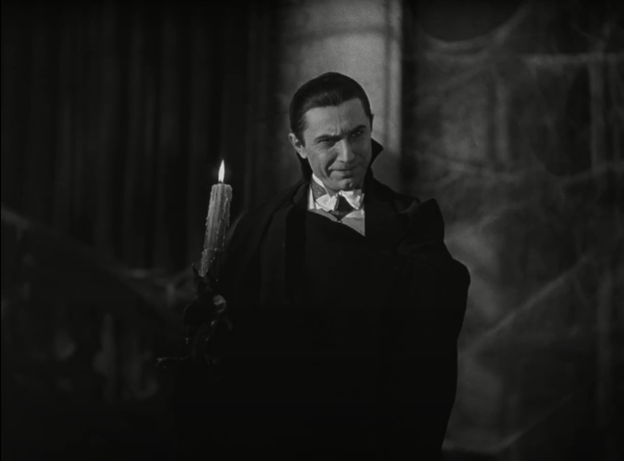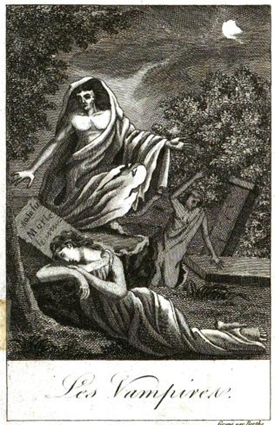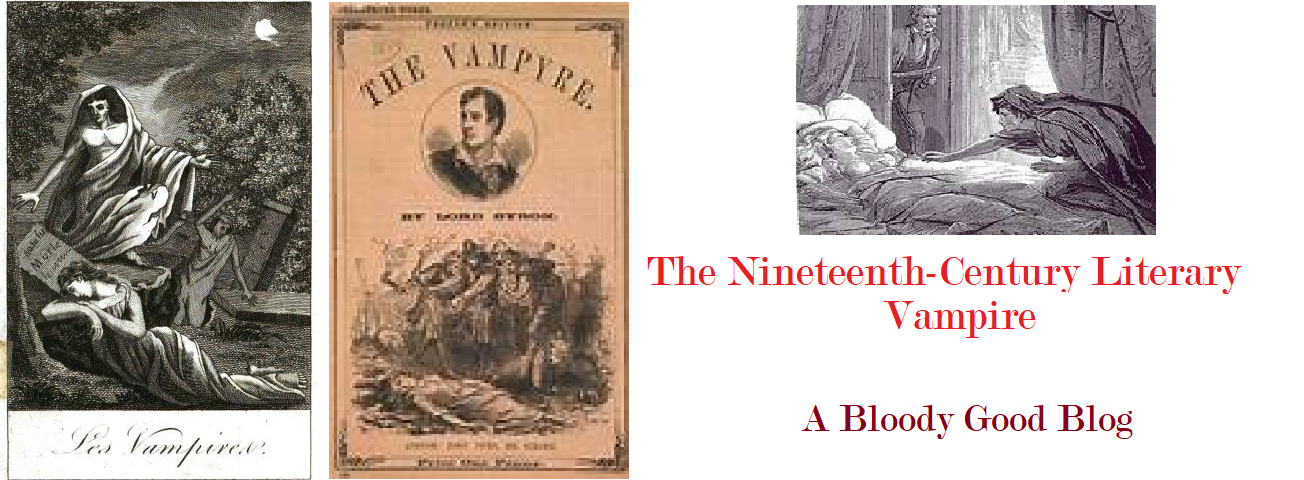We are all familiar with the connection between the sun and vampires. It’s a lethal thing in the modern consciousness, causing bloodsuckers to burst into flames or glitter like diamonds beneath its rays. The sun is both a staple weakness for vampires and such an iconic part of their lore despite how recent of an addition it is within vampire canon, having been first popularized in the 1922 film Nosferatu.

Caption: Bela Lugosi as Dracula in Tod Browning’s 1931 film Dracula. In this scene, Dracula speaks fondly of wolves and similar beasts as “children of the night” making music, creating even more of a bond between vampires and darkness, the night, and the moon in a way similar to Joseph Sheridan Le Fanu’s Carmilla.
But what about the moon? It’s the second-largest celestial body in our sky, and also has more of a presence in classic vampire mythology, most notably in some classical literature read in this class such as Uriah Derick D’Arcy’s The Black Vampire and Joseph Sheridan Le Fanu’s Carmilla. In both of these instances, the moon is viewed as something mystical and a thing of rebirth – which are beliefs also held within traditional folk religions. It’s a thing of magic and life for the undead, contrasting the fatal brutality of the sun in the modern vampire canon. In The Black Vampyre, it’s what gives the titular vampire life, as it’s described prominently upon the rebirth of a young slave boy that’d been kicked back into the sea after washing ashore in the Caribbean.[1]
[1] D’Arcy, Uriah Derick. The Black Vampyre; a Legend of St. Domingo. Printed for the Author, 1819.

Classical pieces of art featuring vampires also happen to feature a lot of Gothic moon imagery as well, highlighting the spiritual natures of vampires and similar creatures.
In Carmilla, the main character Laura notes the magnetic, mystifying pull of the full moon, further highlighting the supernatural feelings of her circumstances when she encounters the vampire Carmilla.[2] “[W]hen the moon shone with a light so intense it was well known that it indicated a special spiritual activity. The effect of the full moon in such a state of brilliancy was manifold” (Le Fanu). The line of ‘special spiritual activity’ is especially interesting to me, given how spiritual classic vampires such as Carmilla come across during an era where spiritualism was becoming more and more popular – which also helps in deepening that mystical connection between vampires and the moon. The moon is a spiritual thing, just as vampires are spiritual creatures. The spiritual is drawn to the spiritual, and further gives more mystique to the connections between vampires and the powers of moonlight.
While in these stories the moon can have a positive connotation, the origins behind such beliefs is sinister – as well as ableist – as the moon has also been a weapon used to demonize things such as mental illness.
Historically, before a modern understanding of diseases, mental illnesses, and the like, such conditions were often associated with lunar cycles and the effects of the moon. While the moon was something of life and strength in older folk beliefs, to the average people of these bygone eras would associate phases of the moon with an individual’s ‘lunacy,’ so frightened superstitions became attached to it.
George D. Hendricks and Mary Washington describe the believed connection between the moon’s lunar cycles and mental illness, noting that aa Tallahassee doctor as late as 1960 believed that “layman know more about this than we do and are reluctant to enter the [mental] hospital at this time” (Hendricks and Washington 197). Here, again, a doctor connects mental illness to the moon. Even the use of the word ‘layman,’ or someone who may be uneducated, indicates how even those who aren’t doctors or professors hold superstitions about the moon and how it has an effect on ill individuals.
[2] Le Fanu, Joseph. “Carmilla.” The Project Gutenberg eBook of Carmilla, by Joseph Sheridan Le Fanu, www.gutenberg.org/files/10007/10007-h/10007-h.htm. Accessed 14 July 2023.
Hal Arkowitz and Scott O. Lilienfield describe this belief as the “lunar lunacy effect” or the “Transylvania effect,” which alludes to the belief that in medieval Europe humans were thought to transform into monsters such as werewolves and vampires beneath a full moon.[3] Here, while there may be no outward and apparent symbolism regarding mental illness allegories with vampires, there is still that underlying, sinister history where people use things such as the moon and its cycles to demonize mental illnesses, something they lacked the understanding of up until recent centuries.
Mental illness and similar allegories are a topic that aren’t as widely discussed when it comes to the topic of vampires, and that’s what makes me so interested in this topic. Yes, we know that physical illness and bloodborne diseases are often associated with monsters such as vampires, but what about mental illness?
Given the fact that they suck on blood and possess association to animals known to carry diseases such as bats and rats – and even ticks, mosquitoes, and fleas – there is the connotation of bloodborne diseases at play. Then there is the physical illness, with the fact that these creatures are dead and not made of living flesh. But what of the mental health aspect of it all? People don’t often associate vampires with mental illness the way they do depictions of creatures like werewolves. But even then, vampires are monsters, nonetheless, therefore making illness and similar afflictions something monstrous.
Once again, I return to D’Arcy’s The Black Vampyre and Le Fanu’s Carmilla. In both of these novellass, the vampires have their allegories of mental illness extending beyond the fact that they’re vampires. Each stories’ respective vampires can be coded as mentally ill (by the standards of their eras) because of their sexuality, gender, nationality, and race.
[3] Arkowitz, Hal. “Lunacy and the Full Moon.” Scientific American, 1 Feb. 2009, www.scientificamerican.com/article/lunacy-and-the-full-moon/.
Along with the moon, one of the strongest thematic connections with vampires is homosexuality and homoeroticism, and the eras’ social anxieties pertaining to the topic. Up until terrifyingly recently, homosexuality was often associated with an unsound mind or impure sexuality, and sexuality in general (especially for women; even today), even heterosexuality if you were a woman, was a topic of scrutiny that would be tied to ideas of ill, impure minds. And this comes to the forefront famously in Carmilla, which stars a lesbian female vampire who actively preys on an innocent young girl. It reflects the Victorian Era social anxieties surrounding female sexuality and homoeroticism, both of which were treated as illnesses of the mind in their respective eras.

Carmilla illustration by David Henry Friston.
So not only does the moon hold an insidious history behind the demonization of mental illnesses, but the history of warped social norms, anxieties, and fear surrounding women, sexuality, and the mind influence depictions of vampires.
To demonize vulnerable or marginalised people, some felt it necessary to turn them – whether they be aging folk beliefs, mental illness, female and queer sexuality, race relations, the aging aristocracy – to turn them into literal monsters. While vampires are creatures that are now viewed as glamorous and elegant, they’re monsters nonetheless, and only curate more fear around these topics. Vampires are intended to be monsters that challenge the worldview of the heterosexual, white, rich male, and that’s why such topics are framed as something monstrous and horrifying and demonic.That’s why it is important to bring up how the mentally ill have been characterised not just as vampires, but as monsters in generaland how these depictions leak into the modern-day vampire canon. The history of why these monsters are monsters helps audiences understand them, the era in which they hail from, and what they mean, and they may even see bits of themselves within monsters such as vampires. It’s important to know how this history translates into our most beloved, monstrous media villains, heroes, and lovers.
Ultimately, the sun and moon present themselves as dichotomies within vampire canon. While the sun presents itself as something of death and pain for vampires, and victory for the heroes, the moon gives the vampires life and power, and terror to protagonists.
Works Cited
Lilienfield, Scott O., and Hal Arkowitz. “Lunacy and the Full Moon.” Scientific American Mind, 20, no. 1 (2009): 64–65. JSTOR, http://www.jstor.org/stable/24940069. Accessed 14 July 2023.
D’Arcy, Uriah Derick. The Black Vampyre; a Legend of St. Domingo, ed. Duncan Faherty and Ed White. Just Teach One, no. 15 (2019). https://jto.americanantiquarian.org/the-black-vampyre/the-black-vampyre/
Le Fanu, Joseph Sheridan. Carmilla. Project Gutenberg. www.gutenberg.org/files/10007/10007-h/10007-h.htm. Accessed 14 July 2023.
Hendricks, George D., and Mary Washington. “Blood and the Moon.” Western Folklore, 21, no. 3 (1962): 197. JSTOR. https://www.jstor.org/stable/1496963

82 comments